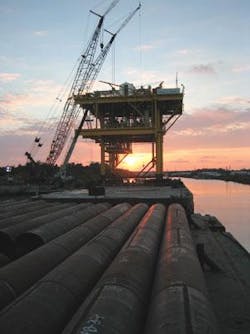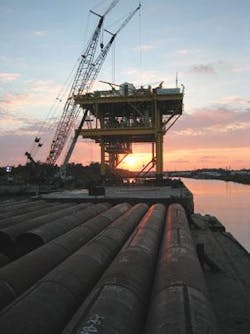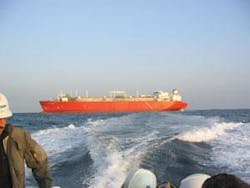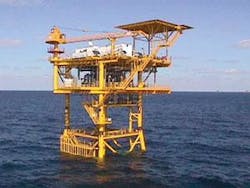LNG regasification vessel with submerged turret loading begins regular service
Jonathan W. Cook; Excelerate Energy
World demand for natural gas continues to expand, which is opening new opportunities for the transport and sale of LNG. In the US, declining gas volumes from the Gulf of Mexico shelf and limited imports from other areas leave the market constrained and requiring new sources of supply. LNG is one answer to the US’ declining production and growing demand.
The US also has limited LNG facilities (four historic and one new port) in active use, with many new facilities, both onshore and offshore, under consideration. Most of the onshore facilities are meeting strong local resistance. Excelerate Energy recently placed an offshore LNG facility, Gulf Gateway Energy Bridge, into service to meet this challenge.
Energy Bridge port
Gulf Gateway Energy Bridge is in the GoM at West Cameron block 603. The port, licensed under the Deepwater Port Act, recently entered service.
The deepwater port consists of a submerged turret loading (STL) system comprising a submerged turret buoy, anchor chains and lines, and anchors. There is also a flexible high-pressure gas riser and a subsea manifold. Other components of the deepwater port include a 20-in. delivery pipeline, a small metering platform, a riser, an interconnect pipeline for the Sea Robin system, and a second interconnect pipeline system that ties into the Tennessee gas pipeline, Blue Water system.
When an Energy Bridge regasification vessel (EBRV) reaches the location of the deepwater port and gains clearance to proceed to moor, the vessel’s crew retrieves and connects to the STL buoy. Pre-attached retrieval lines draw the buoy upward from its submerged location. Once secured inside the vessel, the buoy serves both as the mooring platform and the offloading mechanism for transferring natural gas at pre-designated pipeline pressures.
When all of the pre-start transfer operations have been satisfied, the regasification and delivery process begins. Gas runs through the buoy into the subsea flexible high-pressure riser, and moves from the riser to a pipeline end manifold (PLEM). After this, the gas travels through a 20-in. pipeline that carries it to the metering platform for distribution to the Sea Robin and/or Blue Water systems.
The submerged turret loading system includes a turret buoy, anchor chains and lines, and anchors.
After metering, gas pressure is reduced to the pipeline pressure prescribed by the pipeline operator. The natural gas moves from the metering platform to a 20-in. downstream interconnect pipeline that crosses portions of West Cameron blocks 602 and 601 and interconnects with Sea Robin on East Cameron block 335. The second 20-in. pipeline from the platform crosses a portion of West Cameron block 600 and interconnects with the Blue Water system on West Cameron block 601.
The location of the STL system at West Cameron block 603 is favorable for a number of reasons. This block does not expect any future exploration activities, so locating the facility on this block will not have an adverse impact on any future availability of oil or gas from this area of the outer continental shelf.
Locating the facility at West Cameron block 603 also puts it close to existing offshore pipeline transportation systems that have available capacity. This enhances the value of the deepwater port for competitive trading markets throughout the area. This block is free of surface structures and underwater obstructions. With the area clear of obstructions, there are limited impediments to navigation of the vessel or the transfer of natural gas at the facility.
The water depths at West Cameron block 603 fall within the optimal range of the mooring buoy system, between 40 m and 100 m. And although West Cameron block 603 is not within any established shipping lanes, EBRVs can easily access it from two different directions.
Excelerate Energy�s regasification vessel, Excelsior, is a standard 138,000-cu-m LNG carrier with increased boiler capacity and six vaporization trains.
The buoy and mooring system can withstand a 100-year GoM storm event with a vessel attached. The deepwater port buoy provides a stable mooring platform for continued transfer operations in seas up to 11 m, and the eight-point mooring system can sustain the forces of a moored vessel even when one of the anchor wires becomes damaged or broken.
The maximum pipeline delivery pressure at the site will not exceed 1,250 psi. Normal delivery at the maximum discharge rate requires from six to eight days to complete. During cargo delivery, a designated terminal person-in-charge is on board the EBRV monitoring the arrival, discharge, and departure evolutions.
The facility includes a 3-km navigation zone with its center at the center of the STL buoy’s anchor spread. The maximum anchor leg radius is approximately 1,192.5 m.
The completed metering platform awaits delivery of its first LNG shipments.
El Paso’s Global LNG group began developing the Energy Bridge concept in 2000, when the company forecast that regasification capacity would become the bottleneck for increased LNG imports into the US. At that point, the company began investigating various methods for adding receiving capacity, including both onshore and offshore solutions.
Evaluation covered various offshore solutions, including gravity based structures (GBS), floating storage and regasification units (FSRU), and EBRV. The company decided to develop the EBRV concept based on the high cost of the GBS and FSRU concepts coupled with a desire to create a system that provided maximum reliability of deliveries in the widest range of weather conditions. Excelerate Energy purchased the technology and projects from El Paso in 2003.
The EBRV is a standard 138,000-cu-m LNG carrier with a number of significant modifications. The EBRV has increased boiler capacity from 56 tons/hr to 71 tons/hr, a feature that provides additional steam capacity for closed-loop regas operations. The onboard regasification plant consists of six vaporization trains, including two small high-pressure LNG pumps, six large high-pressure LNG pumps, and six shell and tube vaporizers.
The STL compartment contains the mating cone and gas connector for the STL buoy, high-pressure gas swivel, and high-pressure flexible gas riser. And the LNG containment system is specially reinforced to accommodate the sloshing loads of a partially filled cargo tank. The EBRV is certified for unrestricted liquid levels in North Atlantic conditions.
The EBRV also has a special maneuvering assistance and positioning system to assist with the maneuvering to and retrieval of the STL buoy. This system includes the addition of a second bow thruster, a stern thruster, an acoustic positioning reference system, and a computerized system that allows the unit to maintain station over the buoy until it is locked in place.
The subsea components of the Energy Bridge system include:
- The STL buoy from Advanced Production and Loading AS (APL)
- A flexible high-pressure gas riser that provides the connection for gas delivery from the buoy to the PLEM
- Eight anchor legs consisting of suction anchors with chain and wire anchor lines.
The design philosophy used proven technologies whenever possible. For example, the company selected the APL buoy because it has been employed in shuttle tanker service in the harsh weather environments of the North Sea for over a decade, and the shell and tube vaporizers have been used at various land-based regasification facilities.
The development process included wave tank model testing at Marintek, sloshing load simulation performed by GTT and Bureau Veritas, Hazid/Hazop performed by Lloyds Register, maneuvering simulations at Marine Safety International and the Antwerp Maritime Academy, and a full-scale motion test of the vaporizer witnessed by ABS.
System operations
The regasification plant on the EBRV can vaporize up to 690 MMcf/d of LNG with all six vaporizers online in open-loop mode. In this configuration, the vessel draws in seawater at approximately 50,000 gal/hr and discharges the water back to the sea. At the design seawater temperature of 58.5° F, the water temperature is decreased by 13.5° F during this process.
The system can also operate in closed-loop mode, in which the steam from the ship’s boiler reheats the water fluid circulated to the vaporizers. This system could be used in areas where the ambient seawater temperature is less than 45° F. In seawater temperatures from 45° F to 58.5° F, a combination mode is available that allows shipboard steam energy to supplement the available heat energy in the seawater.
When the EBRV arrives at the Energy Bridge port, the STL compartment floods, and the hatch at the bottom of the compartment opens. A forerunner deployed through the STL compartment, is retrieved to the deck and connected to a messenger line that is used to grapple the pick-up line connected to the submerged STL buoy, which rests approximately 100 ft beneath the surface when not connected to the ship. The pick-up line then runs to the traction winch.
The traction winch is a heave-compensating, constant-tension winch that reels the buoy into the mating cone, where six hydraulic cams lock it into place. The outer cone of the buoy rotates on bearings around the inner turret section, allowing the vessel to rotate, maintaining a heading into the environment.
Once connected, the high-pressure swivel attaches to the top of the buoy, completing the connection of the vessel’s regasification plant to the delivery system.
The vaporizers then come online, and the vessel begins regasifying its cargo at the prescribed rate. Regasification at the nominal rate of 500 Mcf/d takes approximately six days to complete and provides complete redundancy for all installed components of the process plant.
Once the vessel completes the regasification process, the gas pressure is relieved in the subsea riser and shipboard piping. The high-pressure swivel tucks away, and the buoy releases, lowering to its resting position about 100 ft beneath the surface of the water. The Energy Bridge deepwater port is then ready for the next vessel.
Future
The Energy Bridge concept is receiving worldwide attention now that the GoM port is in operation. Current plans include seven US projects.
An expansion of the newly operational Gulf Gateway will double its capacity, and six proposed offshore LNG ports off the Atlantic and Pacific coasts would serve different markets.
Off the eastern seaboard, the Northeast Gateway off Boston and Liberty Gateways off Philadelphia will serve the northeast and mid-Atlantic states. A Southeast Gateway off the east Florida coast will serve the southeastern states. Off the western coast, the Golden Gateway will serve the California market, while the Pacific Gateway off the Mexican coast will serve that country’s growing need for LNG service.
Strong international interest have come from over 20 countries. Inquiries include seven countries in Europe, three in the Mediterranean, eight across south and southeast Asia, four in the eastern Pacific, and three in the western Atlantic.
With growth in the conventional LNG fleet expanding the global LNG shipping market, the Gulf Gateway Energy Bridge has a new spot market opportunity. Cargo trans-shipment will serve the growing LNG spot market.
EBRVs will meet a conventional LNG vessel on the water, transfer the cargo, and then release the conventional carrier to return for another load without the delay of a port call. EBRVs will then transfer the cargo to the Gulf Gateway offshore port. This market is expected to double between 2005 and 2008.
Excelerate Energy completed its Gulf of Mexico deepwater LNG port in January with all required offshore components installed and commissioned, ready for the arrival of the first Energy Bridge Regasification Vessel (EBRV).
Hurricane Ivan affected the installation schedule for the GoM project, Gulf Gateway Energy Bridge, in 2004, but the project sustained no damage. Although installation timing was modified to accommodate weather conditions and installation vessel availability, there was sufficient buffer in the project schedule so that the final completion date was not affected.
Excelerate Energy completed and installed the metering platform jacket and topsides, and laid all subsea pipelines along with the pipeline end manifold (connecting the buoy and riser to the subsea pipeline). Excelerate dewatered, purged, and packed the pipelines and PLEM in mid-December 2004.
Additionally, Excelerate completed and installed the submerged turret loading (STL) buoy Advanced Production and Loading (APL) provided along with the necessary chains and wire rope of the anchoring system.
The first EBRV,Excelsior, arrived Jan. 14. The second vessel, Excellence, arrived in May. The third vessel has a delivery target date of October 2006.
Project construction and completions included participation from a number of companies. Exmar NV of Belgium ordered the EBRVs. Exmar’s technical management affiliate Tecto is operating the vessels. Daewoo Shipbuilding and Marine Engineering in South Korea constructed the ships. APL designed, supplied, and installed the STL buoy, flexible riser, and mooring system. El Paso Field Services acted as contruction manager for the meter platform and subsea pipelines. Twin Brothers Marine constructed the metering platform. McDermott and Stolt Offshore conducted offshore installation activities. Ship Construction Strategies provided design expertise and acted as owner’s engineer for the entire project, including both shipborad and offshore equipment.







